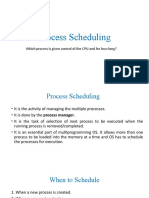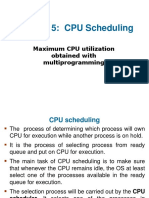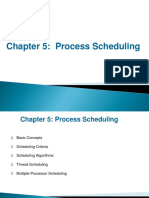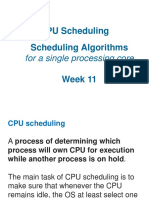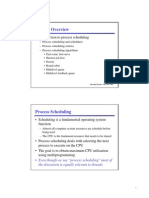0 ratings0% found this document useful (0 votes)
26 views14 pages5) Unit 3 Numerical Ref
CPU scheduling is a critical component of multiprogrammed operating systems, determining the order of process execution to optimize performance. There are three types of schedulers: long-term, medium-term, and short-term, each serving distinct roles in managing process queues. Key scheduling objectives include fairness, throughput, predictability, and minimizing waiting time, with various algorithms like First-Come, First-Served and Shortest-Job-First employed to achieve these goals.
Uploaded by
bapeho4982Copyright
© © All Rights Reserved
We take content rights seriously. If you suspect this is your content, claim it here.
Available Formats
Download as PDF or read online on Scribd
0 ratings0% found this document useful (0 votes)
26 views14 pages5) Unit 3 Numerical Ref
CPU scheduling is a critical component of multiprogrammed operating systems, determining the order of process execution to optimize performance. There are three types of schedulers: long-term, medium-term, and short-term, each serving distinct roles in managing process queues. Key scheduling objectives include fairness, throughput, predictability, and minimizing waiting time, with various algorithms like First-Come, First-Served and Shortest-Job-First employed to achieve these goals.
Uploaded by
bapeho4982Copyright
© © All Rights Reserved
We take content rights seriously. If you suspect this is your content, claim it here.
Available Formats
Download as PDF or read online on Scribd
You are on page 1/ 14
CPU SCHEDULING “WY
———— ee
The scheduling done by CPU is the basis of multiprogrammed operating systems.
Scheduling refers to a set of policies and mechanisms built into the operating system that
govern the order in which the work to be done by a computer system. A scheduler is an
operating system module that selects the next jobs to be admitted into the system and the
next process to run. The primary objective of scheduling is to optimize system performance
in accordance with the criteria deemed most important by the system designers.
In this section we examine that what is scheduling, when to schedule and how do we
perform scheduling ? We begin by describing the roles of these different types of schedulers
encountered in an operating system. Then we describe the objectives and criteria of
scheduling. Finally we describe various scheduling disciplines.
4.1| TYPES OF SCHEDULERS
Generally, there are three types of schedulers, which may coexist in a complex operating
system:
2 Long term scheduler
> Medium term scheduler
> Short term scheduler.
Fig. 4.1 shows the possible traversal paths of jobs and programs through the
components and queues, in a computer system.
As shown in figure 4.1 a submitted batch job joins the hatch queue while waiting tot
‘processed by the long term scheduler. Once, scheduled for execution, processes spawned
by the batch job, enter the ready queue to await the processor allocation bY
the short term scheduler. After becoming suspended in waiting queue, the runnits
process may be removed fram memory and swapped out to secondary storage. ‘Such
processes are subsequently admitted to main memory by the medium term scheduler”
order to be consider ion by the term
j Modiantorm
schodulor
Walling &
Long torm ‘swapped out},
schedulor quouo
Ud
Short torn
Batch ‘Schadulor
jobs_[ Batch
ou it A.) ay
Interactive asl
Watting
ams
progr quouo
Fig. 4.1 Scheduler
opJECTIVES OF SCHEDULING
4
are many objectives that must be considered in the design of scheduling discipline
qhere
uch as:
i) Fairness: Fairness can be reflected by treating all the processes same and no
(a process should suffer indefinite postponement.
(i Throughput: It must attempt to service the largest possible number of processes
per unit time.
(ii) Predictable: A given job should run in about the same amount of time and at the
same cost irrespective of the load on the system.
(i Overhead: A certain portion of system resources invested as overhead can greatly
improve overall performance of the system.
(4 Resources: Scheduling mechanism should keep the resources of the system busy.
(0) Indefinite Postponement: Avoiding indefinite postponement of any process so
that each and every process is executed in a certain amount of time.
(vi) Priorities: Scheduling mechanism should favour the high priority processes.
SCHEDULING CRITERIA
taty criteria have
FF Cleristics used
© best algorith;
'C ss,
?U Utilization
eh
en it gh KeeP the CPU as busy as possible. It may range from 0 to 100%. In a real,
‘ould range from 40 — 90% for lightly loaded and heavily loaded systems.
been suggested for comparison of CPU scheduling algorithms. The
for comparison can make a substantial difference in the determination
m. The criteria includes the following:
Wovehput
sti te'gk
lng prone R°ASUre of work in terms of number of processes completed per unit time. For
"be 19 Se this rate may be_1 process per hour; for short transactions, throughput
~ Process per second.
SS
a. t i
58 nt in wot to ge
ound TIME iods SPC Vi fle,
of time ae nd eer pletion of job
ol
into memory, Waiting in y,
o
i
= e of submission of jo}
tis the sum
oe, executing 7
‘urn around
ate
quew time nite trae Ating
fect the @ hi
i s not aft articular system. It affert ®t:
ret el ing 2 ort ne are ones Oe a queue. Waiting times
8 jo because they iting in :
or Ss
f time that @ ae in ready queue:
ds
the amount o ting i
jods
gum of time-perno ; . ;
: not the time ‘aken to out; rut
« Response Time ponding, mil
It is the amoun!
response.
4| TYPES OF SCHEDULING
ptive scheduling schemes: ; :
take place under the following four circumstances;
g state to the waiting state (for exam
S|
tof time, it takes to start res
Nonpreemptive and preemy
‘CPU scheduling decisions may f
() When a process switches from the runnin,
input/output wait).
(i) When a process switches from the running state to the ready state (for exampk
when an interrupt occurs).
(i) When a process switches from the waiting state to the ready state (for exampk
completion of input/output).
(iy) When a process terminates.
Inci i i —
Place only under (9 and (iv) Gein selected for execution. When scheduling tak
However, in circumstances (i) and aa ‘ay the scheduling scheme is Nonpreemptire
au i i il ae, .
Process may or may not be selected, f i) there is a choice in terms of scheduling ie!
Preemptive. for its execution, this type of scheduling is alld
Under nonpreempti
tive scheduli
Process keeps ey eouling, once thi ‘
i¢ Waiting ae i = ay antl it releases the ae has been allocated to a ‘process,
then is ecaton ee APOE start gehe” Y terminating or by switche!
oe ny interruption ao ted until the Process j ‘on under nonpreemptive schedulit
oF timer” needed for wrcemption, ‘Asa Gg dene keeution completes its burst we
aan i ‘Mptive ; not : ; wi
completion of baPtive sched, ae Scheduling, require any special hard\
in
Whose priority ie oo time of fe,
execution
her than riage 88 and any a Process is preempted before w
West arrive Process 1 Process may starts its execu”
in th
e system,
it ibe in thy.
* Jor Ls, .
i aes : ;
ed to the Nee term med; ection is teat
'y any of the above des
ee _ typ cri
o 4
e of Short temanng sath
59
—__CPU Scheduling
CPU scheduling deals with the
eve is lo be allocated the
algorithm that exist:
freblem of decicing which of the process in arene
CPU. Now we describe neveral of the many CPU scheduling
4.5.1 First-Come, First-Served (ECF:
‘S) Scheduling Algorithm
FCFS is the simplest of all
sche
(ting algorithms. ‘The key concept of this algorithm is
ou Culing, aly ! Y pt of this
raltocated the CPU in the order in whch ae Processes arrive.” That is the process that
requests the CPU first is allocated the cry first. The implementation of FCFS policy is
managed with a FIFO (First-in-firat out qe
its PCB is linked onto the tail of the
process at the head of the que
The code for FCFS scheduling
When a process enters the ready queue,
queue, When the ©
We. The running proc
is simple
FCFS Scheduling Algorithm is Non.
Once the CPU has been given toa
the CPU cither by terminating or by re
for Batch operating system. The aver,
especially if requests of short CPU b
for time-sharing systems where it j
PU is free, it is allocated to the
s is then removed from the queue.
to write and understand.
Preemptive
keeps the CPU until it releases
‘The FCFS algorithm is suitable
tems * important that each user should get the CPU for an
equal amount of arrival time,
>
fe Pe —! oy
Ready Queen
Fig. 4.2 FCFS Scheduling
EXAI
MPLE 4.1 Consider the fol
TRE Set of processes having their burst time mentioned in
milliseconds. CPU-burst time indicates that for hew muck time, the process needs the CPU.
Process Burst Time (ms)
Pp 20
P, 7
P, 5
Calculate the average waiting time if the processes arrive in the order of;
() Py, Py, Py (i) Py, Py, Py
(tt) P,, P,P, (iv) Pay Poy Py
Solution: ( If processes arrive in order P,, P,, P; let us assume at 0 ms, 1 ms and 2 ms
Tespectively, wait
Process Burst time Arrival time
Py 20 0
P, 7 1
Py 5 2
Since, FCFS is a non-preemptive algorithm; so when a process execution is started it
is not preempted until its execution is completed,
The Gantt chart will be:
a Py Pa
1
60 Operating Systems
Waiting time for process Py = 0 ms
Waiting time for process 2,” 20 ms ~1ims = 19 ms
Waiting time for process P,* 27 ms = 2 ms © 25 ms
0419425
Average waiting time = 4 ma
© 14.67 ms.
Consider a case, if the processes P,, 2, and Py arrives at the same time say at 0 ms in
the system, in the order of P,, P,, Py then:
Waiting time for process P, = 0 ms
Waiting time for process P, = 20 ms
Waiting time for process P, = 27 ms
0+20427 47
3 ms = —> ms = 15.67 ms.
(i Ifthe processes P,, P,, P, arrives at the same time say at 0 ms in the system and in
the order of P,, P,, P, then the Gantt chart will be
». Average waiting time =
Pe Py Py
oO 7 12 32
Waiting time for process P, = 0 ms
Waiting time for process P, = 7 ms
Waiting time for process P, = 12 ms
O+7412 19
—j ms = J ms = 6.33 ms.
(ii) If the three processes P,, P, and P, arrives at the same time say 2 ms in the order
of P,, P,, P, then the Gantt chart will be
Average waiting time =
Ps Py i
2 7 27 32
Waiting time for process P, = (7-2) ms = 5 ms
Waiting time for process P, = (27 - 2) ms = 25 ms
Waiting time for process P, = 0 ms
5+25+0 320 ge 10 SS
-—T ms = > ms = 10 ms, ime
(iv) If the processes arrive in the order of P,, P,, P, at the same time say 0 ms then the
Gantt chart will be ate
©. Average waiting time =
Py Py P,
Waiting time for process P, = 12 ms
Waiting time for process P, = 5 ms
CPU Scheduling
Wailing time for process Py = 0 ing
‘ 124540 17
+. Average waiting time : ma = Fins = 5.67 ms.
Hence, from the example it in clear that if Processes of short burst time arrives firstly
then the average waiting time is minimum.
So, in FOFS scheduling order of proceagen plays am:
average waiting time,
ajor role in the measurement of
4.5.2 Shortest-Job-First (SJFI Scheduling Algorithm
sim ancorate SIF) scheduling isa different approach to Cpu scheduling. This
algorithm associates with each proceas the length of the latter's next CPU burst. When the
CPU is available, it is assigned to the process that hae din smallest next CPU burst. If the
two proces: have the same length of CPU burst then FCF: scheduling algorithms is
followed. As scheduling is done by examin, st of
The key concept of this algorithm is
burst time”. This algorithm is considered
fhe process with least CPU —
minimum average waiting time as a result.
to be an optimal algorithm, as it gives the
controls the relative weight of rece
then a formula called exponent:
; and t, stores the past history in prediction
=> recent history has no effect (current conditions are
assumed to be transient)
ifa= 0, then t,,, = 1,
fa~ 1, then t,,,=t,=9 in this case only the most recent CPU burst matters.
Ha 1/2 then recent and past history are equally weighted.
The SJF algorithm. may be either preemptive or non-preemptive
The choice arises when a new
process arrives in the ready queue while a previous
Process is executing,
i i i the execution
A preemptive 8JF will preempt this currently executing process and starts i
of newly entered Process while non-preemptive SJF will allow the currently executing
Process to complete its burst time without any interruption in its execution.
Preemptive SJF scheduling is sometimes called Shortest-Remaining-Time-First (SRTF)
Scheduling,
a Operating Systems
IS
2a Process Arrival time Burst time
Pr, 7 .
Py a 7
’ : -
3 8
Py
hedulit ti) Non
Calculate Average waiting time in (i) preemptive SJF scheduling and (ii) Non. Preemptive
SUF scheduling.
Solution: (i) Preemptive SUF:
IP} Pe Pa Py Ps
o123 5 10 17 26
PP,
At t= 0 ms only one process P, is in the system, whose burst time is 8 ms; starts jt
execution. After I ms, ie, at t= 1, new process P, (burst time = 4 ms) arrives in the ready
queue. =: Its burst time (4 ms) is less than the remaining burst time of P, (7 ms) so p, ig
preempted and execution of P, is started. Again after one ms ie., at t= 2, a new process p.
arrive in ready queue but its burst time-(9 ms) is larger then the remaining burst time of
currently executing process (3 ms). So P, is not preempted and it continuous its execution,
Again after one ms at f= 3, new process P, (burst time = 5 ms) is arrived but again for the
same reason P, is not preempted until its execution is completed. At t~ 5 all the processes
have arrive in the system. Now the processes are executed in SJF scheduling manner
resulting as following:
Waiting time for process P, = 0 ms + (10 - 1} ms = 9 ms
Waiting time for process P, = 1 ms ~ 1 ms = 0 ms
Waiting time for process P, = 17 ms - 2 ms = 15 ms
Waiting time for process P, = 5 ms ~ 3 ms = 2 ms
+0+15+2
=. Average waiting time aerst2 ms
8 65 A
= 7 765ms. Ans.
(i) Non-Preemptive SUF:
, Pa Pe Ps
0 P, P,P, 8 12 7 26
At t= 0 ms only one process is in the ready queue P, (burst time = 8 ms). Since in non-
preemptive scheme when a process starts its execution then it is not preempted unless its
burst time is completed. So, even P,, P, and P, are arrived one after the another in the:
duration of one ms P, continues its execution upto 8 ms, After this processes are executed
in the accordance of SJF scheduling resulting as following: Persone
Waiting time for process P, = 0 ms eS
Waiting time for process P, = (8-1) ms = 7 ms
Waiting time for process P, = (17 - 2) ms = 15 ms § a
Waiting time for process P, = (12-3) ms = 9 ms
2 _CPU Scheduling 68
Average wai
4.5.3 Priority Scheduling
Apriority is associated with each
the highest priority, Equat-priority p,
An SJF is simply a priority algorit
next CPU burst. The larger the CPU b,
Priorities are generally some fixed ers such as 0 to 7. However.
no general agreement on whether O is the hi
low numbers to represent low priori
ty; others use low numbers to represent higher Priority.
This difference can lead to confusion,
i In our text we use low numbers to Tepresent
high priority.
EXAMPLE 4.3 Consider the following set of processes,
0 » assumed to have arrived at time 0, in
the order P,, Pay... Ps » with the length of the CPU-burst thne given in milliseconds:
Process Burst time Priority
Pp 10 3
P, a 1
P, 2 4
P, 1 5
Ps 5 2
Using priority scheduling calculate average waiting time.
toe ae, Using Priority scheduling, we would schedule the given processes according to
the following Gantt chart:
Py Py | Py
16° (18 19
o4 6
Waiting time for process P, = 6 ms
Waiting time for process P, = 0 ms
Waiting time for process P, = 16 ms
Waiting time for process P, = 18 ms
Waiting time for process P, = 1 ms
6+0+16+18+1
Avg. waiting time = S
ms = 8.2 ms,
Priority Schedulin,
When a proces:
Tuning process.
th A Preemptive priority scheduling algorithm will preempt the CPU if the priority of
new
: yack eH tly running in
® atived process is higher than the priority of the process current
he system. a nan preeniaage ¢ priority scheduling algorithm will simply put the new
€ is Either Preemptive or Non-preemptive
S$ arrives at ready queue, its priority is compared with the currently
Sn
Operating Systems
64 __ Operating Sy
i sseoetiaumree
_— y queue locs not preempt the execution of
of the ready queue d ; cure,
Pree at head of Wht ention even when the priority of newly arrived process is higher
Pha priority inthe process currently running in the system,
than priority of
EXAMPLE 4.4 Preemptive Priority Scheduling
Process Burst time Priority Arrival time
P, 10 3 o
Pr, 5 Es 1
P, 2 1 2
tution: Initially we have a process P; (burst time = 10 ms) in the system,
Ton thems. at {= Lnew process P. (5 ms) and priority 2 arrives in the systems. Since
ite prionty is higher than the priority of P,(3), So Pi is preempted and P, started its execution”
Aeun at 2, Py (priority ~ 1) arrives So P, is preempt for the same reason and Pris
Again ot (nil Hs execution is completed, Since P, has got highest priority among the
ses. After the completion of P;, remaining part of process P, starts its executio;
riority then P,. So, the Gantt chart is as: n
three proce:
as it is got higher p
Py} Pe| Ps Pe Py
o12 4 8 “
Waiting time for process P, = 0 ms + (8~ 1) ms = 7 ms
Waiting time for process P, = (4-2) ms = 2 ms
Waiting time for process P, = (2-2) ms = 0 ms
T+24+0
2 Average w. a
ae
ms = 3 ms.
Priorities may be assigned by the user or by the operating system, depending upon the
importance of the process. A natural question that arrises here is:
What will happen if the two processes having same priorities ? The tie will be
broken by comparing their CPU burst time. i rter burst time is firsth
executed and if there may be a situation that two processes having same burst time then
they are executed on the basis of FCFS scheduling.
‘The problem with priority scheduling algorithm arises when it becomes the biggest
cause of starvation of a process. If a process is in ready state but its execution is almost
always preempted, due to the arrival of higher priority processes, it will starve for its
execution.
Therefore, a mechanism called “ageing” has to be built into the system so that alinost
every process should get the CPU in a fixed interval of time. This can be done by increasing
the priority of a low-priority process after a fixed interval of time, so that one moment of
time it becomes a high-priority job as compared to others and thus, finally gets CPU for its
execution.
4.5.4 Round-Robin Scheduling Algorithm
‘The Round-Robin (RR) scheduling algorithm is desi ime-sharing
oun igned especially for time-sharing 5}
It is similar to FCFS scheduling algorithm, but preemption is added to switch'b
processes. A small unit of time called a time
quantu: ime-slice) is, define
range is kept between 10 to 100 ms. in. (or time-slice) ieageny
st
CPU Scheduling 65
port-term) goes around the ready queue,
(rerval of upto 1 time quantum.
Toimplement RR scheduling, we keep the reatly queue as a FIFO Queue of the processes.
New processes are added to the tail ofthe ready queue The crn scheduler picks the first
process from the ready qucue, sets a timer to int,
Trupt after 1 time quantum, and dispatches
the process.
One of the two things may happen. The process
time quantum. In this case, the
en
Ready Queue
Fig. 4.3. RR scheduling
If there are N processes in the ready
Process gets 1/N of CPU time in hunks of at most ‘t’ times units.
Each process must wait no longer than (N
quantum.
queue and the time quantum is ‘t, then each
~ 1) * t time units until its next time
EXAMPLE 4.5 Consider the following set of processes that arrives at time O ms.
Process Burst Time
P, 20
P, 3
Ps; 4
Iie use time quantum of 4 ms then calculate the average waiting time using R-R scheduling.
eva [er [eevee | eae [iene] cee
4 7 W 15 19 23 27
o-
Solution: According to R-R scheduling processes are executed in FCFS order. So, firstly
Fi (burst time = 20 ms) is executed but after 4 ms it is preempted and new process Py
‘urst time = 3 ms) starts its execution whose execution is commpleted can Ee ‘time
uantum then next process P, (burst time = 4 ms) starts its execution and finally remaining
Part of P, gets executed with time quantum of 4 ms.
Waiting time of process P, = 0 ms + (11 - 4) ms = 7ms
Waiting time for process P, = 4 ms
aiting time for process P, = 7 ms
T+447
Average waiting time = —3-— ms = 6 ms.
66 Operating Systems
4.5.5 Multilevel Queue Scheduling Algorithm
‘The other types of scheduling algorithims has been created for situations in which processes
are easily classified into different groups. ; :
‘A Multilevel Queuc Scheduling (MQS) algorith 1m partitions the ready queue into severa]
separate qui he processes are permanently assigned to one queue, generally based
dn Some property of the process, such as memory size, process priority or process type,
Bach queue has its own scheduling algorithm. For example, different queues can be used
for foreground and b: und processes. The foreground queue might be schedule
‘an RR scheduling algorithm, whereas background queues are scheduled by FCFS
‘scheduling algorithm.
ein addition, there must be scheduling among the queues, and is generally implemented
as fixed priority preemptive scheduling.
For example, the foreground queue may have absolute priority over the background
queue. Let us consider an example of a multiliver queue scheduling algorithm with 5
queues :
()) System processes
(ii) Interactive processes
(iii) Interactive editing processes
(iv) Batch processes
(v) Student processes
Highest Priority
‘System Processes [_-
eee Interactive Processes |__.
| interactive Exiting Processes = -——~
—| Batch Processes —
fae Student Processes }—~
Highest Priority
Fig. 4.4 MQS algorithm
Each queue has absolute priority over lower priority queues. No process in the. batch
queue, say, could run unless the queues for system processes, interactive processes;
interactive editing processes were all empty. If an interactive editing process ente!
eae
the ready queue which a batch process is running then the batch process would be
preempted.
4.5.6 Multilevel Feedback Queue Scheduling ete
A scheduling mechanism is expected to fre
O favour short jobs
CPU Beheduling,
u favour lnpat/outpat bound Job1 10 net yood input/output device utilization.
u Determine the natite of job quickly and achedule it ac ordingly.
U MEQH provides and atructuey.hat agpomplishen thege.goals,
Anew pricenn entora the quicuing networleat the brick of the top queue. It moves
through the FIFO Queue untiLit gets the CPU.
u Ifthe Job completen or relinquiahen the
completion of Kome event, tHe
CVU to wat for input/output completion or
Job leaven the queuing network,
the process voluntarily relinquishes the CPU, the
1eof next lower level queue,
‘d when it reaches the
OI the quanti expiren before
procenn in placed at the bn
‘The process in next nerviee
head of the queue of the first
queue in empty,
© An tong an the procens uses the full
move to the back of the next lower quewc,
‘Bn many multilevel feedback queue g
{t moven to cach lower-level queue be
een in the queuing networ
the CPU,
G Mululevel feedback queues are i al for separating processes into categories based
on their need for the CPU, In a time sharing system, cach time a process leaves
the queuing, network, it can be “stamped” with the identity of the lowest level
queue in which it resides. When
the process reenters the queuing network, it can
be sent directly to the queue in which it last completed operation
Here, the ucheduler is using the heuristic that the recent past behaviour of a process
is & good indientor of its near future behaviour. So, a CPU bound process returning to the
aucuing network is not put into the higher level queues, where it would interne with
service to high priority short processes OR input/output bound processes.
duantum provided at cach level, it continues to
hieo) Py Py Py P, —+ [cru].
Proomption
P,P, P, —~ [cru] —-
Proomption
Proomption
al a
Lovoln ——s PF,
Py Pp P, —+ [cru] —-
A
Fig. 4.5 Multiple Feedback Queue.
Operating Systems
68
eee eee
EXAMPLE 4.6 Consider the set of processes given in the table and the following scheduling
algorithm:
{i) Shortest Job First (SUF)
(ii) Shortest Remaining Job First (SRIF) .
| Process id ‘Arrival time | Executive time }
A ° 7
B 1 5
c 2 3
D 6 2
E 12 3
irthere is a tie within the processes, the tie is broken in the favowe of the oldest process.
Draw the Gantt chart and find the average waiting time and fur, around time for the two
Rigorithms. Comment on your result which one is better and why?
Solution: (i) For SUF the Gantt chart will be:
A. pic E B |
o BoD 7 9 1215 20
Waiting time for process id A= 0
Waiting time for process id B= (15-1) = 14
Waiting time for process id C= (9-2) =7
Waiting time for process id D= (7-6) = 1
Waiting time for process id B= (12 - 12)=0
Average waiting time = ore telse
=44 unit. Ans.
Turn around time for process id A=7-O=7 ~
Turn around time for process id B= 20-1 = 19
Tum around time for process id C= 12-2 = 10
Turn around time for process id D= 9-6 = 3
Tum around time for process id B= 15-12 =3
74194104343
Average turn around time = 5
= =8.4 unit. Ans.
You might also like
- IT 106 UNIT 2 Lesson 2 CPU Scheduling AlgorithmNo ratings yetIT 106 UNIT 2 Lesson 2 CPU Scheduling Algorithm84 pages
- Cpu Scheduling: by Noordiana Binti Kassim at Kasim / Mohd Hanif Bin Jofri / Ceds UthmNo ratings yetCpu Scheduling: by Noordiana Binti Kassim at Kasim / Mohd Hanif Bin Jofri / Ceds Uthm34 pages
- Scheduling: Ren-Song Ko National Chung Cheng UniversityNo ratings yetScheduling: Ren-Song Ko National Chung Cheng University57 pages





